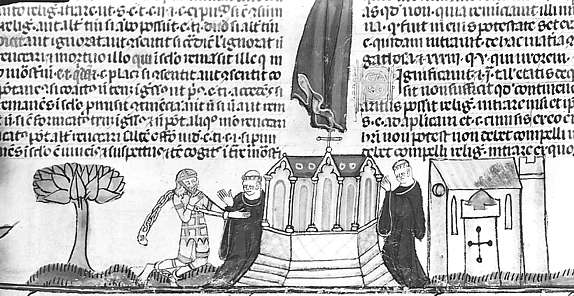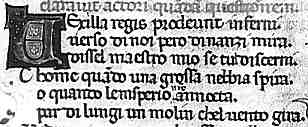






If you are looking at this page without frames, there is more information about medieval writing to be found by going to the home page (framed) or the site map (no frames).
| The Strange History of Humanistic Minuscule (2) | ||||
| The word Gothic is one which has been used in various contexts. First there were the Goths, hairy horribles who rampaged across Europe as the Roman Empire fell to bits. Consequently their name has been taken to categorise various things considered to be northern and barbaric, medieval, uncouth; generally not good. The architectural marvels of late medieval western Europe are described as Gothic, but they were not particularly admired by many Italians, who largely stuck to their traditional Romanesque architectural styles. The term Gothic was used to describe the typefaces produced in Germany, as opposed to the Roman typefaces which we know and love, but when the term was projected back on to the handwriting styles that preceded these typefaces, I do not know. All I do know is that in Italy they preferred their rounded architectural design to the pointy northern style, and the same went for their handwriting. Nevertheless, some of the original Goths settled down in Spain and became civilised and Mediterranianised, and I guess something similar happened with the writing. But should we call it Gothic? | ||||
 |
||||
| Segment of a page from the Decretals of Gregory IX, early 14th century, written in Italy and illustrated in England (British Library, Royal 10 E IV, f.206v), by permission of the British Library. | ||||
| If you look carefully at the writing in the above example, you will find the Gothic sloping d, short curly s and simplified r after o. Ascenders and descenders are short, so that the writing is vertically compressed, but the letters are rounder, the bases curved rather than angular and the letters not really laterally compressed. It has certain characteristics of what we call Gothic, but not as angular and pointy as some, so it is generally designated as Gothic rotunda. Nonetheless, the whole range of Gothic is a continuum, not discrete sets of bounded national styles. Unfortunately, the text is chopped up as the photographer appears to have been more interested in the guy praying at the tomb of St Dunstan to release him from some medieval bondage gear. I have included him for your delectation and delight. | ||||
 |
This is a segment from a 14th century Italian copy of Dante's Divine Comedy (British Library, add. ms. 19587, f.58a). By permission of the British Library | |||
| We tend to think of formal Gothic scripts in relation to liturgical works, but a famed national poet writing in his vernacular could warrant this special treatment. Apart from those few particular Gothic letter forms, and some letter combinations which join together, but without compressing the shapes of the individual letters, this could pass for a Caroline minuscule. | ||||
| There is a script sample and paleography exercise for this one. | ||||
| This sample is from the Melissande Psalter (British Library, Egerton 1139, f.210), made between 1131 and 1143 in Jerusalem. By permission of the British Library. |  |
|||
| The rotunda style was not confined to Italy, but was also found in southern France and Spain. This early example comes from the Holy Land. Just a minute, the d is upright, the final s is long. Are we only calling this Gothic rotunda at all because it was written in the 12th century? The main Gothic characteristic that it has is extensive abbreviation, as well as some little flicked up bases to the letters. | ||||
| This also has a script sample and paleography exercise. | ||||
 |
An example of littera bononiensis from a 14th century work of Johannis Andreae Novella on the Decretals (Vatic 1456, v.f.179). (From Ehrle and Libaert 1932) | |||
| The very dense form of script used for textbooks at the University of Bologna, known as littera bononiensis, is a tiny cramped form of rotunda. It gets huge amounts of text on a page, not by lateral compression, but by very, very tiny simplified writing with a massive amount of abbreviation. In fact, as in the northern Gothic tradition, the use of abbreviation in these kinds of scholarly texts is so extreme that I sincerely believe that they were not made for reading in the way we do it today, as the primary means of gaining new information. They are surely for jogging the memory for texts originally learned orally. In those days university students did not have tutorials in which they argued noisily about issues. They were talked at, and read at, and they copied it down or followed the text in their own copies of the work. Absorb, remember, assimilate, but do not explore and interpret too much. Hold on to these ideas. We are getting closer to the 15th century. | ||||
| As elsewhere, while the writers of books were developing their special scripts, an ever increasing army of writers was drafting legal documents. In Italy these were generally notaries whose documents were a legal instrument, ratified with their unique notary's mark. In England, legal documents involving such matters as land transfers tended to be short and snappy. Even in the late middle ages they were really a recording of a witnessed oral legal process. In Italy they could be exceedingly long. There were also recorders of court processes, and there were writers of business affairs. As elsewhere, they utilised a range of cursive scripts appropriate to their purposes. | ||||
| Some of these had a certain elegance. | ||||
 |
||||
| Small random grab from a contract of sale, with notarial endorsement, being the last membrane of a roll which originally comprised 20 membranes, from a private collection. | ||||
| Others display a neat functionality. | ||||
 |
||||
| Grab from a damaged fragment of a court roll of the later 14th century from Italy, from a private collection. | ||||
| There is a script sample for this one, but no paleography exercise yet. | ||||
| Others may be what you might call stylishly scruffy. | ||||
 |
||||
| Grab from the top left of a fragment of a charter from Florence dated 1370, but you can read that for yourself, from a private collection. | ||||
| Those who could write both book hand and document hand were able to combine these to produce a different style of book hand, but paleographers do not bestow unflattering titles implying illegitimacy on these Italian scripts. Possibly this is because the result was in many cases truly beautiful. Possibly because this was the Renaissance, so you cannot imply that anything associated with it was a bastard. Possibly it was because they came up with something really new, or was it? And we are finally nearly up to the 15th century. | ||||
|
|
||||
|
If you are looking at this page without frames, there is more information about medieval writing to be found by going to the home page (framed) or the site map (no frames). |
||||